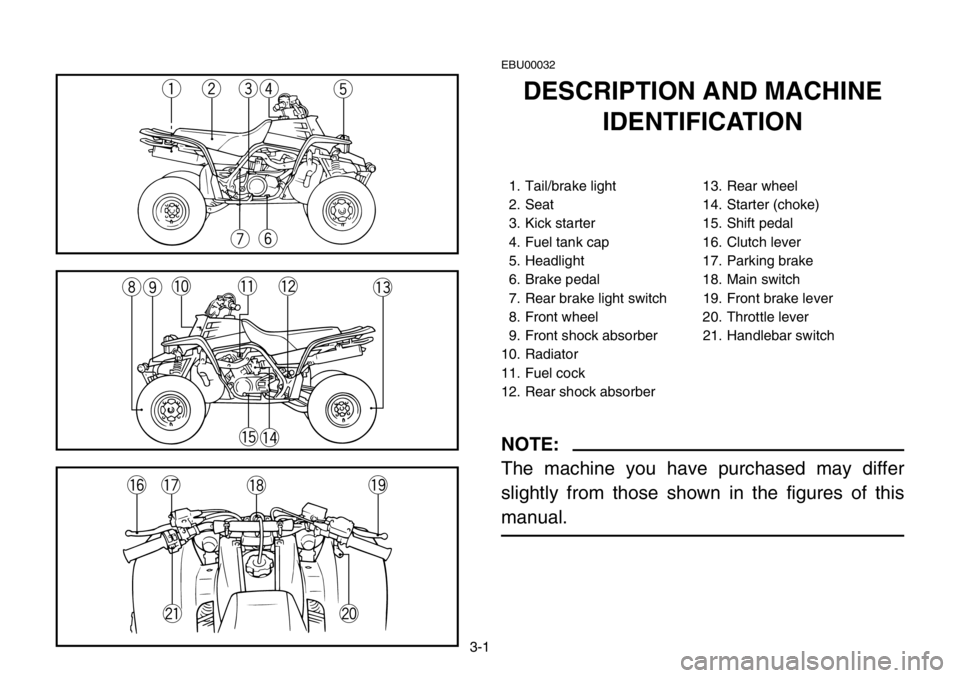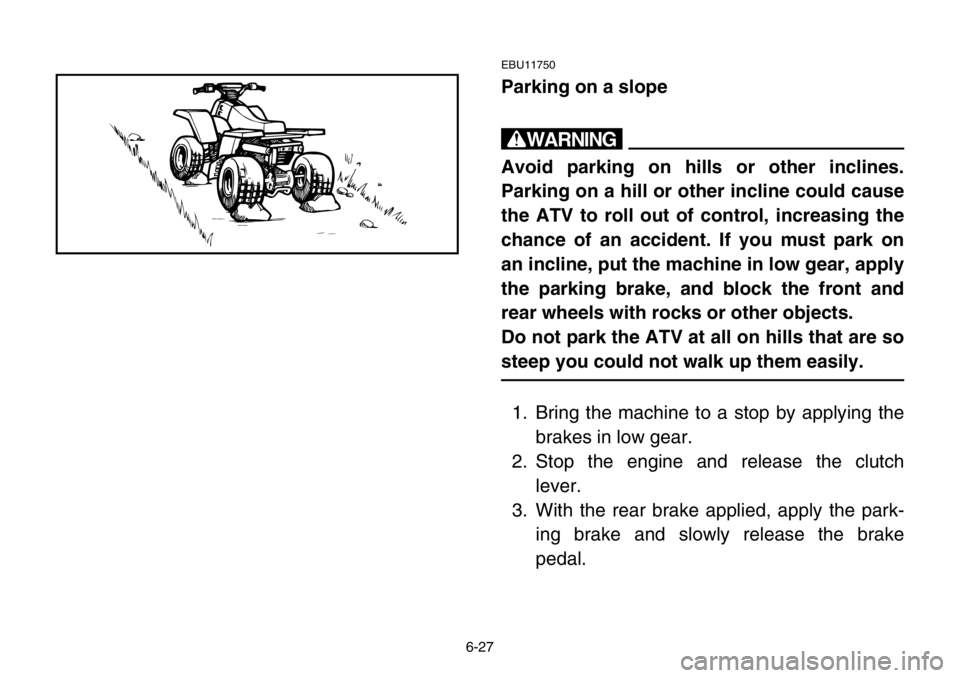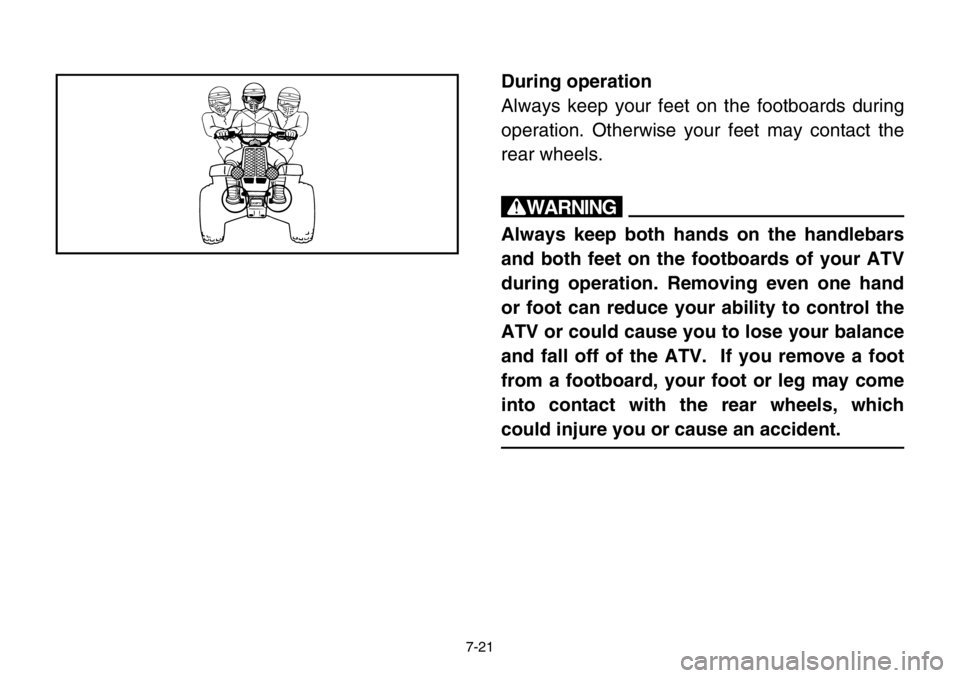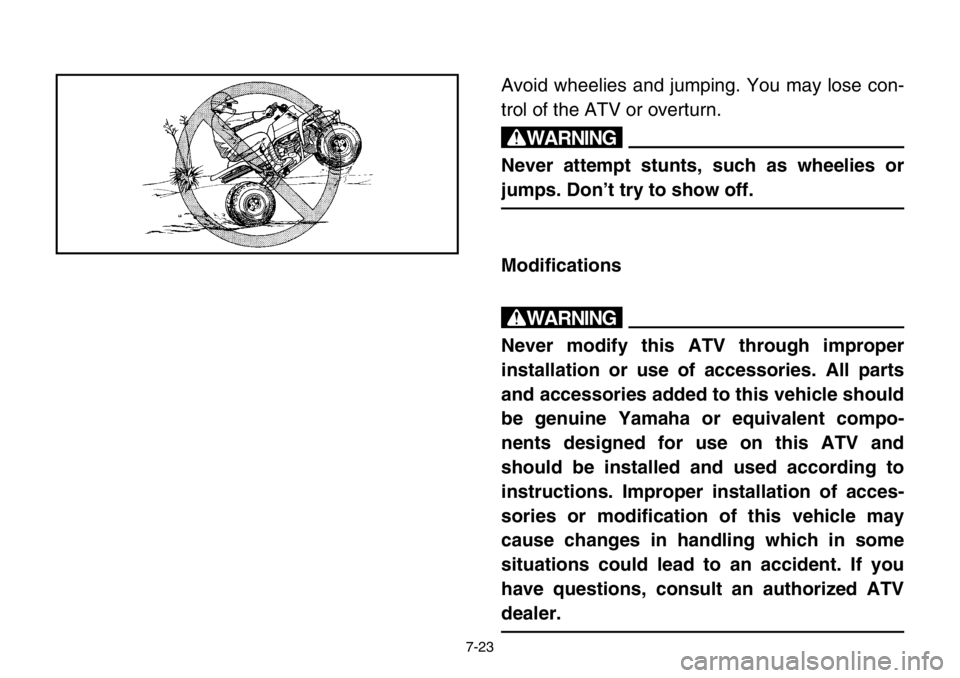wheel YAMAHA BANSHEE 350 2004 Owners Manual
[x] Cancel search | Manufacturer: YAMAHA, Model Year: 2004, Model line: BANSHEE 350, Model: YAMAHA BANSHEE 350 2004Pages: 396, PDF Size: 3.55 MB
Page 14 of 396

Cooling system ...................................8-23
Spark plug inspection .........................8-39
Air filter cleaning .................................8-43
Carburetor settings .............................8-51
Idle speed adjustment ........................8-67
Throttle lever adjustment ....................8-71
Front and rear brake pad
inspection .........................................8-73
Brake fluid level check ........................8-75
Brake fluid replacement ......................8-79
Front brake lever free play .................8-81
Brake pedal height adjustment ...........8-83
Parking brake adjustment ...................8-85
Adjusting the rear brake light switch ...8-89
Clutch adjustment ...............................8-91
Drive chain slack check ......................8-91
Drive chain slack adjustment ..............8-93
Lubricating the drive chain .................8-95
Cable inspection and lubrication ........8-99Brake and shift pedal/brake and
clutch lever lubrication ....................8-101
Front upper and lower arm pivot
lubrication .......................................8-101
Rear arm pivot lubrication ................8-103
Wheel removal .................................8-105
Wheel installation .............................8-105
Replacing the headlight bulb ............8-107
Headlight beam adjustment ..............8-109
Tail/brake light bulb replacement .....8-111
Troubleshooting ................................8-113
Troubleshooting chart .......................8-117
CLEANING AND STORAGE ...................9-1
A. Cleaning ...........................................9-1
B. Storage ............................................9-7
SPECIFICATIONS .................................10-1
10
9
Page 34 of 396

2-5
8Never operate at speeds too fast for your skills
or the conditions. Always go at a speed that is
proper for the terrain, visibility and operating
conditions, and your experience.
8Never attempt wheelies, jumps, or other
stunts.
8Always inspect your ATV each time you use it
to make sure it is in safe operating condition.
Always follow the inspection and maintenance
procedures and schedules described in this
manual.
8Always keep both hands on the handlebars
and both feet on the footrests of the ATV dur-
ing operation.
8Always go slowly and be extra careful when
operating on unfamiliar terrain. Always be
alert to changing terrain conditions when oper-
ating the ATV.
Page 48 of 396

3-1
EBU00032
DESCRIPTION AND MACHINE
IDENTIFICATION
1. Tail/brake light 13. Rear wheel
2. Seat 14. Starter (choke)
3. Kick starter 15. Shift pedal
4. Fuel tank cap 16. Clutch lever
5. Headlight 17. Parking brake
6. Brake pedal 18. Main switch
7. Rear brake light switch 19. Front brake lever
8. Front wheel 20. Throttle lever
9. Front shock absorber 21. Handlebar switch
10. Radiator
11. Fuel cock
12. Rear shock absorber
NOTE:
The machine you have purchased may differ
slightly from those shown in the figures of this
manual.
e
r
t
ywq
u
!6!7
!8!9
@1@0
i!0!1o!2
!3
!4 !5
Page 96 of 396

5-1
EBU00113
PRE-OPERATION CHECKS
Before using this machine, check the following points:
ITEM ROUTINE PAGE
Brakes9Check operation, free play, fluid level and fluid leakage. 5-5–5-9
9Fill with DOT 4 brake fluid if necessary. 8-73–8-83
Clutch9Check operation, condition and lever free play. 8-91
Parking brake9Check operation, condition and free play. 8-85–8-87
Fuel9Check fuel level.
9Fill with fuel if necessary.5-11–5-13
Transmission oil9Check oil level.
9Fill with oil if necessary.5-17, 8-17–8-23
Coolant reservoir 9Check coolant level.
9Fill with coolant if necessary.8-23–8-37
Drive chain9Check chain slack and condition.
9Adjust if necessary.5-21, 8-91–8-97
Throttle9Check for proper throttle cable operation. 5-21, 8-71
Wheels and tires9Check tire pressure, wear and damage. 5-25–5-31, 8-105
Fittings and Fasteners9Check all fittings and fasteners. 5-21
Lights and switches9Check for proper operation. 5-23, 8-107–8-111
Page 144 of 396

6-17
7. Open the throttle part way and gradually
release the clutch lever.
8. Follow the same procedure when shifting to
the next higher gear.
w
Opening the throttle abruptly or releasing the
clutch lever too quickly would increase the
chance of an accident or could make the
machine wheelie including overturn. Always
open the throttle gradually and release the
clutch lever gradually.
Page 146 of 396

6-19
EBU00208
To decelerate
When slowing down or stopping, release the
throttle and apply the brakes smoothly and
evenly. As you slow down, shift to a lower gear.
Be sure that the engine has sufficiently slowed
before engaging a lower gear. Improper use of
the brakes or shifting can cause the tires to lose
traction, reducing control and increasing the
possibility of an accident.
w
Make sure the engine has sufficiently slowed
before shifting to a lower gear. Engaging a
lower gear when the engine speed is too
high could make the wheels stop rotating.
This could cause loss of control, an accident
and injury. It could also cause engine or
drive train damage.
Page 154 of 396

6-27
EBU11750
Parking on a slope
w
Avoid parking on hills or other inclines.
Parking on a hill or other incline could cause
the ATV to roll out of control, increasing the
chance of an accident. If you must park on
an incline, put the machine in low gear, apply
the parking brake, and block the front and
rear wheels with rocks or other objects.
Do not park the ATV at all on hills that are so
steep you could not walk up them easily.
1. Bring the machine to a stop by applying the
brakes in low gear.
2. Stop the engine and release the clutch
lever.
3. With the rear brake applied, apply the park-
ing brake and slowly release the brake
pedal.
Page 186 of 396

7-21
During operation
Always keep your feet on the footboards during
operation. Otherwise your feet may contact the
rear wheels.
w
Always keep both hands on the handlebars
and both feet on the footboards of your ATV
during operation. Removing even one hand
or foot can reduce your ability to control the
ATV or could cause you to lose your balance
and fall off of the ATV. If you remove a foot
from a footboard, your foot or leg may come
into contact with the rear wheels, which
could injure you or cause an accident.
Page 188 of 396

7-23
Avoid wheelies and jumping. You may lose con-
trol of the ATV or overturn.
w
Never attempt stunts, such as wheelies or
jumps. Don’t try to show off.
Modifications
w
Never modify this ATV through improper
installation or use of accessories. All parts
and accessories added to this vehicle should
be genuine Yamaha or equivalent compo-
nents designed for use on this ATV and
should be installed and used according to
instructions. Improper installation of acces-
sories or modification of this vehicle may
cause changes in handling which in some
situations could lead to an accident. If you
have questions, consult an authorized ATV
dealer.
Page 202 of 396

7-37
With the engine idling, pull the clutch lever to dis-
engage the clutch and shift into 1st gear, and
then release the parking brake. Open the throttle
gradually, and at the same time, release the
clutch lever slowly. Once the ATV has attained
adequate speed, release the throttle lever and at
the same time, quickly pull in the clutch lever and
shift into 2nd gear. Open the throttle part way and
gradually release the clutch. Use this same pro-
cedure as you move into the higher gears. Be
sure to coordinate the use of the throttle and shift
pedal properly. If the throttle is applied too
abruptly or if the throttle is not released during
shifting, or if the shift pedal is not released before
applying the throttle, the front wheels may lift off
the ground resulting in a loss of directional con-
trol. Avoid higher speeds until you are thoroughly
familiar with the operation of your ATV.
w
Always open the throttle gradually and
release the clutch lever slowly. Otherwise,
the ATV could wheelie which would increase
the chance of an accident.